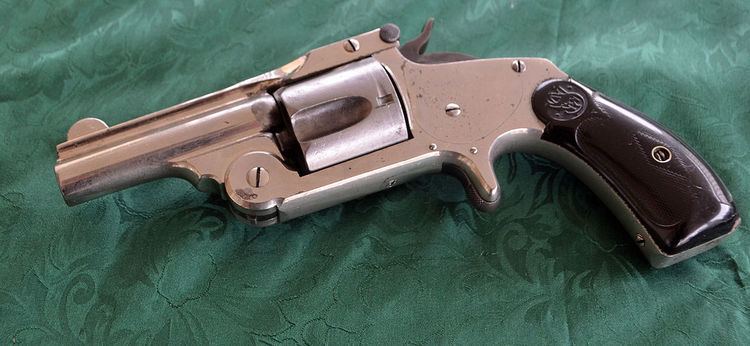Type Revolver Used by United States Produced 1876-1911 | Place of origin United States Manufacturer Smith & Wesson | |
 | ||
No. built approx. 25,548 (1st model), 108,255 (2nd model), 97,000 (3rd model) | ||
The Smith & Wesson Model 2 also referred to as the Smith & Wesson .38 Single Action and Smith & Wesson .38 Single Action was Smith & Wesson's first .38 caliber revolver. Chambered in .38 S&W, its cylinder held 5 shots. The single action version was produced in three varieties from 1876 through 1911, with total production exceeding 223,000.
Contents
The Smith & Wesson Model 2 was a "top-break", with the barrel release catch located on the top of the frame, just in front of the hammer. It was a larger caliber version of the third model of the Smith & Wesson Model 1 1/2.
Single Action
In 1876, Smith & Wesson Model 2 debuted in a single-action format, meaning the hammer had to be cocked manually to set the trigger in order to fire the revolver. These revolvers were available in nickel or blued finishes.
1st Model
The first model of the .38 Single Action can be identified by its smooth barrel (lacking fluting), and the long extractor shroud similar to the Smith & Wesson Model 3 Russian pistol, which lent it the nickname "Baby Russian". It had a spur trigger and lacked a trigger guard. Models were available in blued or nickel-plated finishes, and the majority were produced with 3 1⁄2-inch or 4-inch barrels, although barrels as long as 7 inches were sold.
Serial numbers range from 1 through to 25,548 between 1876 and 1877. This pistol was used by the Baltimore Police Department from 1876 to 1917 and such revolvers are marked "City of Balto".
2nd Model
The second model of the 38 Single Action used a shorter and more efficient ejection and extraction system and lack the shroud of the 1st model. It was produced in blued steel and nickel-plated versions, with most models having a 3 1⁄2-inch or 4 1⁄2-inch barrel. Rare versions had barrels of 6, 8 and 10 inches in length.
These revolvers had a spur trigger, lacked a trigger guard and were serial numbered consecutively from 1 through 108,255.
3rd Model
The third model of the 38 Single Action was made from 1891 to 1911 and is often known as the 1891 Model, Model 01 or the Model of 91 as the latter is stamped on the top of the barrel. This version used a standard trigger and a trigger guard, but 2000 of these revolvers were made for the Mexican government with the spur trigger and no guard and are referred to as the "Mexican Model".
Double Action
In 1880, Smith & Wesson offered the Model 2 in a double-action format, whereby a single squeeze of the trigger both cocked the hammer and fired the revolver. These revolvers were available in nickel or blued finishes and a smaller version was offered in .32 Smith & Wesson. They were made as late as 1937, being eclipsed by the stronger hand-ejector models.
Double Action 32
The Model 2 in .32 S&W was made in 5 iterations. The initial version was a batch of 30 revolvers that were the first of such made by Smith & Wesson with a trigger guard in 1880. These models were deemed to be sub-par and did not leave the factory until 1888. The second version was improved and a total of 22,142 of these were manufactured until 1882. The third variant made from 1882 untuil 1885 included 22,232 revolvers. The fourth version was made from 1885 until 1909 and included 239,600 models. The final fifth variant included 44,641 pieces and was discontinued in 1919.
Double Action 38
The Model 2 in .38 S&W was made in 5 iterations. The initial run consisted of 4000 revolvers in 1880. The second version was improved and a total of 115,000 of these were manufactured from 1880 until 1884. The third variant made from 1884 until 1895 included 203,700 revolvers. The fourth version was made from 1895 until 1909 and included 216,300 models. The fifth variant included 15,000 pieces and was discontinued in 1911. The third and fourth versions saw use as a police revolver for the cities of Cleveland, Ohio, Boston Massachusetts and Baltimore, Maryland as well as for security guards at the American Express Company.
The final version of these top-break double-action 38's was the Perfected Model. This version used a top break with a sideplate thumb latch and was made from 1909 until 1920 for a total of 59,400 revolvers. This model was used by Floyd Allen in a courthouse escape attempt in 1913.
